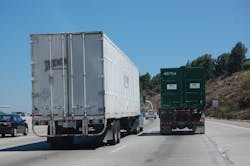Little truck capacity expected to be added, survey finds
A recent survey of TL carriers by consulting firm Transport Capital Partners (TCP) determined that while 65% of them are planning to add capacity, they remain extremely conservative in terms of how much they will add – with over three-quarters of carriers planning to add little (1% to 5%) or no capacity in the coming 12 months.
Only 24% of carriers in the survey planned capacity increases of more than 5%, noted Richard Mikes, a TCP partner.
“Carriers continue to voice concerns about the ‘headwinds’ impacting operations and returns,” Mikes added, pointing out that larger carriers are being more cautious than smaller carriers in their truck buying plan, with just 19% of larger carriers planning to add more than 5% capacity compared to 36% of smaller carriers.
Some of the “headwinds” facing carriers include the still-sluggish pace of U.S. economic growth, rising diesel fuel prices, and the still-unknown impact of recent changes to hours of services (HOS) regulations.
While the Bureau of Economic Analysis (BEA) noted that U.S. gross domestic product (GDP) increased 1.7% in the second quarter, first quarter GDP growth got revised downward to 1.1% and the agency noted it recently changed how it calculates such GDP data – especially how the agency measures what it calls the “knowledge economy” through investments in research and development and entertainment and the arts.
Those changes alone, BEA told the Wall Street Journal, added $471 billion to the revised $16.2 trillion overall U.S. economy – though agency economists were quick to stress data revisions offer a “slightly recalibrated view” of the U.S. economy in recent years, the findings do not change the overall economic picture.
On top of that, the Department of Labor’s recent jobs report indicated payrolls increased only 162,000 in July – the smallest in four months – and included a downward revision to 188,000 for the number of jobs added in June. Economists had initially forecast a job increase of 185,000 workers for July, noted Bloomberg. Workers also spent fewer hours on the job in July and hourly earnings fell for the first time since October, Labor Dept. data showed.
“First quarter GDP growth has been revised down to 1.1% following 0.1% in the fourth quarter of 2012 [and while] the first estimate for the second quarter is 1.7%, better than expected, [the] revisions for the past two quarters have been negative and large so even that lousy reading may be revised downward,” noted William Dunkelberg, chief economist for the National Federation of Independent Business (NFIB).
“Even so, these GDP growth numbers do not square with the growth in employment averaging over 190,000 per month,” he added. “The growth in part-time jobs may explain part of this ‘inconsistency’ but overall, the job market isn’t looking any better. Overall, there is not a lot of promise for new job growth.”
Closer to trucking’s vest, rising diesel fuel prices and HOS changes are presenting challenges. Wall Street investment firm Robert W. Baird & Co.noted that diesel fuel prices continue to rally after reaching lowest point since July 2012, rising for three consecutive weeks to $3.90/gallon after hitting $3.82/gallon in early July.
And while the firm believes it is still too early to gauge the impact of HOS changes made July 1, productivity is still predicted to take a hit of 1% to 4%, depending on fleet mix.
As a result of such uncertainties, TCP Partner Steven Dutro noted that the most commonly reported method for adding future capacity right now in the TL sector is through company equipment that is either financed or purchased on a TRAC (terminal rental adjustment clause) lease, with 34% of carriers surveyed by the firm indicating this method as their most likely option.
“TRAC leasing rates are lower as lessors pass through the benefits of accelerated depreciation, with carriers giving these tax breaks to lessors (banks and leasing companies) for such rates - attractive particularly when carriers may not have enough profits to utilize them,” Dutro added.
Only 8% of larger carriers polled intend to add capacity by buying an existing company’s fleet, he noted, while adding capacity through buying used trucks declined from 8% in October 2011 to zero today. “Used trucks with low miles are practically non-existent as carriers retain trucks rather than spending scarce cash for new trucks,” Dutro said.
TCP’s Mikes also pointed out that over the past three years, the percentage of carriers intending to add capacity through the use of independent contractors has decreased by 50%, from 30% to 15%, though smaller companies are more likely than larger carriers to still seek out independent contractors (21% vs. 13%).
“Contractors left the industry as their profits and cash flows were depressed in the recession, and many are not interested in returning, even as more carriers offer lease purchase plans to attract them,” he said.
About the Author
Sean Kilcarr
Editor in Chief
Sean Kilcarr is a former longtime FleetOwner senior editor who wrote for the publication from 2000 to 2018. He served as editor-in-chief from 2017 to 2018.
